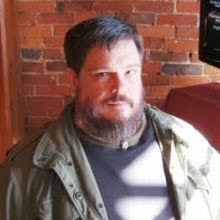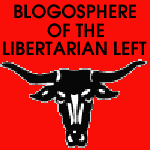Gretchen Ross has an unsettling piece at
UnCapitalist Journal on the abuse of the government's new powers against "domestic terrorism" to go after animal rights activists and "eco-terrorists."
Unfortunately, this is nothing new. The government has been targeting the anti-globalization left and other domestic political enemies, under cover of ostensible "counter-terror" policies, for some time.
The use of "counter-terror" policy to justify domestic police statism originally seized, in the wake of the Oklahoma City bombing, on the pretext of right-wing extremism: the so-called "patriot" or "militia" movement. Clinton's counter-terrorism act of 1996, arguably more dangerous than anything since done by Ashcroft (but give it time), gave the President blanket authority to declare any organization "terrorist" by executive fiat, and then to seize its assets without due process of law. The latter provision has been used by the government since 9-11, by the way: the Justice Department has used the threat of civil forfeiture to force ISPs to close down a number of sites, like (for example) IRARadio, which archived interviews with Sinn Fein leaders. The controversial shutting down of Islamic charities, and the threats of stripping citizenship by administrative fiat from contributors to such charities (which resurfaces periodically in leaked draft legislation), are all built on a legal foundation established by Bill Clinton.
In December 1999, with the Seattle protests, the U.S. government turned on a dime and treated the anti-globalization movement as enemy number one. (Jim Redden, "
Police State Targets the Left" The Zoh Show: Newsbytes (May 2, 2000))
It's quite understandable. Even before the post-Seattle movement caused such panic, RAND analysts were expressing grave concern over the possibilities of decentralized "netwar" techniques for undermining elite control. David Ronfeldt saw ominous signs of such a broader movement in the global political support network for the Zapatistas. Loose, ad hoc coalitions of affinity groups, organizing through the Internet, could throw together large demonstrations at short notice, and "swarm" the government and mainstream media with phone calls, letters, and emails far beyond their capacity to absorb. Ronfeldt noted a parallel between such techniques and the "leaderless resistance" advocated by right-wing white supremacist Louis Beam, circulating in some Constitutionalist/militia circles (
The Zapatists "Social Netwar" in Mexico, MR-994-A (1998)). These were, in fact, the very methods later used at Seattle and afterward. Decentralized "netwar," the stuff of elite nightmares, was Huntington's "crisis of governability" on steroids.
Paul Rosenberg, in "
The Empire Strikes Back," recounts in horrifying detail the illegal repression and political dirty tricks used by local police forces against anti-globalization activists at protests in 1999 and 2000. There have even been some reports that Garden Plot (see below) was activated on a local basis at Seattle, and that Delta Force units provided intelligence and advice to local police. (Alexander Cockburn, "
The Jackboot State: The War Came Home and We're Losing It" Counterpunch May 10, 2000; "
US Army Intel Units Spying on Activists"
Intelligence Newsletter #381 April 5, 2000)
Seizing on the opportunity presented by the 9-11 attacks, Ashcroft's Justice Department was able to push through (via the USA PATRIOT Act) a whole laundry list of police state measures desired by the FBI that Congress had been unwilling to swallow five years earlier. A good many of the most objectionable features of USA PATRIOT were provisions in the original version of Clinton's counter-terror bill that wound up on the cutting room floor in 1996.
Although Al-Qaeda was ostensibly the target of these sweeping new powers, the powers granted under USA PATRIOT have actually been used far more for expanding existing "wars" on drugs and gangs than against Islamist terrorists.
Worse, there are indications that the left-wing anti-globalization movement figures even more prominently than drugs and gangs in the federal enemies list. An especially interesting figure in this regard is John Timoney. As Philadelphia Police Commissioner, he figured prominently in Rosenberg's account of the police riots at the Republican Convention in 2000. There he made what was arguably the most drastic, thorough, and creative use of police spying, harassment, and preventive arrest of activists on trumped up charges, of any local police official involved in fighting the post-Seattle movement. As police chief in Miami, he supervised the police riots against the anti-FTAA protests there.
Timoney has an intense and abiding hatred, not to mention fear, of the anti-globalization movement--or what he calls the "international anarchist conspiracy." He advocated the use of RICO and harsh federal law enforcement tactics to break the anti-globalization movement.
After 9-11, he was a close political associate of Tom Ridge (who had been governor of Pennsylvania and provided political support to Timoney during the events of August 2000), and his name has resurfaced periodically in the mainstream press as a potential appointee to the upper ranks of Homeland Security.
It's also interesting how closely the "economic terrorism" provisions of USA PATRIOT bear on the direct action tactics used by the Wobblies and other radical unions. They could be used, quite effectively, in the same manner as the old "criminal syndicalism" statutes of the post-WWI "Red Scare." For that matter, any damage to property designed to have a political effect is classified as "economic terrorism": any group present at any protest where property damage takes place, whether or not that specific group endorsed or participated in the damage, can fall afoul of USA PATRIOT. Strictly speaking, the participants in the Boston Tea Party could have been treated as "terrorists" under current law.
All these events of the past decade, horrible as they are, are really just the culmination of 35 years of creeping authoritarianism. U.S. policy elites decided, in the aftermath of the great "civil disturbances" of the 1960s (the mass antiwar and civil rights demonstrations and the urban riots), that such levels of violence would never again be tolerated.
In response to the antiwar protests and race riots, LBJ and Nixon began to create an institutional framework for coordination of police state policy at the highest levels, to make sure that any such disorder in the future could be dealt with differently. This process culminated in Department of Defense Civil Disturbance Plan 55-2, Garden Plot, which involved domestic surveillance by the military, contingency plans for military cooperation with local police in suppressing disorder in all fifty states, plans for mass preventive detention, and joint exercises of police and the regular military. Senator Sam Ervin, of the Subcommittee on Constitutional Affairs, claimed that "
Military Intelligence had established an intricate surveillance system covering hundreds of thousands of American citizens. Committee members had seen a master plan--Garden Plot--that gave an eagle eye view of the Army-National Guard-police strategy." (Of course, much of the legal and administrative apparatus needed for preventive detention of "subversives" had been in place since the McCarran Internal Security Act of the Truman era, and was heavily augmented by Kennedy's series of executive orders providing for martial law and federal administration of the economy in the event of "national emergency.")
At first, the Garden Plot exercises focused primarily on racial conflict. But beginning in 1970, the scenarios took a different twist. The joint teams, made up of cops, soldiers and spies, began practicing battle with large groups of protesters. California, under the leadership of Ronald Reagan, was among the most enthusiastic participants in Garden Plot war games.
...Garden plot [subsequently] evolved into a series of annual training exercises based on contingency plans to undercut riots and demonstrations, ultimately developed for every major city in the United States. Participants in the exercises included key officials from all law enforcement agencies in the nation, as well as the National Guard, the military, and representatives of the intelligence community. According to the plan, joint teams would react to a variety of scenarios based on information gathered through political espionage and informants. The object was to quell urban unrest. (Frank Morales, "U.S. Military Civil Disturbance Planning: The War at Home" Covert Action Quarterly, Spring-Summer 2000)
Meanwhile, by the 1970s, the corporate-state elite was reassessing the effectiveness of the New Deal "social compact" and of corporate liberalism in general. They concluded from the 1960s experience that the social contract had failed. Besides unprecedented levels of activism in the civil rights and antiwar movements, and the general turn toward radicalism among youth, the citizenry at large also became less manageable. There was a proliferation of activist organizations, alternative media, welfare-rights organizations, community activism, etc. Together, they amounted to what Samuel Huntington called a "crisis of governability." Increased prosperity for the middle class had failed to buy popular acquiescence.
The wave of wildcat strikes in the early '70s indicated that the business unions were no longer effective in restraining their own rank and file or enforcing management control of the work process. At the same time, the increased bargaining power of labor and the expanding welfare state were leading to the "accumulation crisis" of James O'Connor: the business press of the 1970s was full of alarmist commentary on the looming "capital shortage," and the need for a massive shift of resources from consumption to accumulation.
The result of this reassessment was a broad change in elite thinking from corporate liberalism to the current neoliberal consensus. From the 1970s on, corporate leadership went into full union-busting mode, exploiting all the latent possibilities in Taft-Hartley. By the end of the decade, the Fed's policy of fighting inflation at the cost of increased unemployment (if, that is, unemployment weren't an added feature rather than a bug) further reduced the bargaining power of labor. The new vulnerability of corporations to hostile takeover reduced the autonomy of management, and increased pressure to maximize profits by any available means. The result was a virtual cap on real wages for the past thirty years, with all productivity increases instead being translated into exponential increases in corporate profits and management compensation. The comments in this paragraph, by the way, are based on some
interesting commentary by Brad DeLong on the various structural causes of labor's long retreat. I'll follow this post up with an excerpt.
The welfare state was scaled back, at the same time as direct and indirect state subsidies to accumulation were increased.
There was simply no way that this new austerity policy--the moral equivalent of "structural adjustment"--could be imposed on the public without a major increase in political authoritarianism. Business journals predicted frankly that freezing real wages would be hard to force on the public in the existing political environment. For example, an article in the October 12, 1974 issue of
Business Week warned that
Some people will obviously have to do with less.... [I]ndeed, cities and states, the home mortgage market, small business and the consumer will all get less than they want.... [I]t will be a hard pill for many Americans to swallow--the idea of doing with less so that big business can have more.... Nothing that this nation, or any other nation has done in modern history compares in difficulty with the selling job that must now be done to make people accept the new reality.
The only way to accomplish this massive shift of resources, as Samuel Huntington pointed out in
The Crisis of Democracy, was by insulating the state from democratic pressure. The task of state capitalist elites, in the face of this crisis, was to restore that necessary "measure of apathy and noninvolvement" that had existed before the 1960s, and thus to render the system once again "governable."
As policy elites attempted to transform the country into a two-tier society, a kinder and gentler version of the Third World pattern, the threat of public discontent forced the government to greater and greater levels of authoritarianism. The elite was forced, as
Richard K. Moore put it ("
Escaping the Matrix"), to import techniques of social control from the imperial periphery for use against the core population.
The most obvious means of social control, in a discontented society, is a strong, semi-militarized police force. Most of the periphery has been managed by such means for centuries. This was obvious to elite planners in the West, was adopted as policy, and has now been largely implemented....
So that the beefed-up police force could maintain control in conditions of mass unrest, elite planners also realized that much of the Bill of Rights would need to be neutralized.... The rights-neutralization project has been largely implemented, as exemplified by armed midnight raids, outrageous search-and-seizure practices, overly broad conspiracy laws, wholesale invasion of privacy, massive incarceration, and the rise of prison slave labor.
(See also Sam Smith, "
How You Became the Enemy").
With the help of the Drug War, and assorted Wars on Gangs, Terrorism, etc., the apparatus of repression continued to grow. The Drug War has turned the Fourth Amendment into toilet paper; civil forfeiture, with the aid of jailhouse snitches, gives police the power to steal property without ever filing charges--a lucrative source of funds for helicopters and kevlar vests. SWAT teams have led to the militarization of local police forces, and cross-training with the military has led many urban police departments to view the local population as an occupied enemy. (Diane Cecilia Weber, "
Warrior Cops: The Ominous Growth of Paramilitarism in American Police Departments" Cato Briefing Paper No. 50, 26 August 1999.)
Now local police forces and the military are introducing crowd-control technologies based on high-pitched noise or the electronic infliction of pain: in effect, mass-tasering of hundreds or thousands of people at a time. Considering U.S. elites are so obviously terrified of their own populations, and preparing so diligently for the high-tech repression of popular unrest, it makes you wonder what else they've got up their sleeves. What with the last days of the housing bubble, the dollar's untenable position as global reserve currency, and the bankruptcy "reform" aimed at forcing as many people as possible into Chapter 13 debt slavery, you have to wonder: do they plan to fence off entire communities with barbed wire, turn them into debtors' prisons, and march the populace out into the fields under armed guard to pick cotton for ADM or Cargill? As somebody once wrote in an
Atrios comment thread, I'm starting to feel like I'm living in a Paul Verhoeven movie based on a Phillip K. Dick novel.
SWAT teams, interestingly, were pioneered in California under Reagan, at the time Louis Giuffrida was head of the National Guard. At the time, Giuffrida and Reagan were both enthusiastic supporters of joint military-police exercises for dealing with "civil disturbances" under Garden Plot. In the '80s, when Giuffrida was head of FEMA, he worked with Oliver North to draw up plans for martial law in the event of a "national emergency." They worked together on the Readiness Exercises 1983 and 1984 (Rex-83 and Rex-84), which included mass detention of suspected "terrorist subversives" under the emergency provisions of Garden Plot. The hypothetical civil disturbance/insurrection scenario these emergency exercises were supposed to be coping with, by the way, was a series of massive antiwar demonstrations in response to a U.S. military invasion of Central America.
Lt. Col. Oliver North... helped draw up a controversial plan to suspend the Constitution in the event of a national crisis, such as nuclear war, violent and widespread internal dissent or national opposition to a U.S. military invasion abroad. (Alfonso Chardy, "Reagan Aides and the 'Secret' Government," Miami Herald, July 5, 1987)
So we're back to where we started: terrorism=subversion=disloyalty=un-Americanism. And all four translate, in practice, into threatening the stability of state capitalist domination.








